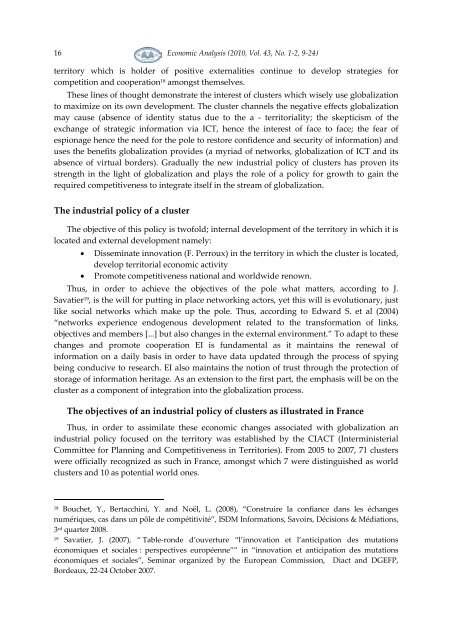Twice a Year Scientific Journal
Twice a Year Scientific Journal
Twice a Year Scientific Journal
Create successful ePaper yourself
Turn your PDF publications into a flip-book with our unique Google optimized e-Paper software.
16<br />
Economic Analysis (2010, Vol. 43, No. 1-2, 9-24)<br />
territory which is holder of positive externalities continue to develop strategies for<br />
competition and cooperation 18 amongst themselves.<br />
These lines of thought demonstrate the interest of clusters which wisely use globalization<br />
to maximize on its own development. The cluster channels the negative effects globalization<br />
may cause (absence of identity status due to the a - territoriality; the skepticism of the<br />
exchange of strategic information via ICT, hence the interest of face to face; the fear of<br />
espionage hence the need for the pole to restore confidence and security of information) and<br />
uses the benefits globalization provides (a myriad of networks, globalization of ICT and its<br />
absence of virtual borders). Gradually the new industrial policy of clusters has proven its<br />
strength in the light of globalization and plays the role of a policy for growth to gain the<br />
required competitiveness to integrate itself in the stream of globalization.<br />
The industrial policy of a cluster<br />
The objective of this policy is twofold; internal development of the territory in which it is<br />
located and external development namely:<br />
• Disseminate innovation (F. Perroux) in the territory in which the cluster is located,<br />
develop territorial economic activity<br />
• Promote competitiveness national and worldwide renown.<br />
Thus, in order to achieve the objectives of the pole what matters, according to J.<br />
Savatier 19 , is the will for putting in place networking actors, yet this will is evolutionary, just<br />
like social networks which make up the pole. Thus, according to Edward S. et al (2004)<br />
“networks experience endogenous development related to the transformation of links,<br />
objectives and members [...] but also changes in the external environment.” To adapt to these<br />
changes and promote cooperation EI is fundamental as it maintains the renewal of<br />
information on a daily basis in order to have data updated through the process of spying<br />
being conducive to research. EI also maintains the notion of trust through the protection of<br />
storage of information heritage. As an extension to the first part, the emphasis will be on the<br />
cluster as a component of integration into the globalization process.<br />
The objectives of an industrial policy of clusters as illustrated in France<br />
Thus, in order to assimilate these economic changes associated with globalization an<br />
industrial policy focused on the territory was established by the CIACT (Interministerial<br />
Committee for Planning and Competitiveness in Territories). From 2005 to 2007, 71 clusters<br />
were officially recognized as such in France, amongst which 7 were distinguished as world<br />
clusters and 10 as potential world ones.<br />
18<br />
Bouchet, Y., Bertacchini, Y. and Noël, L. (2008), “Construire la confiance dans les échanges<br />
numériques, cas dans un pôle de compétitivité”, ISDM Informations, Savoirs, Décisions & Médiations,<br />
3 rd quarter 2008.<br />
19<br />
Savatier, J. (2007), “ Table-ronde d’ouverture “l’innovation et l’anticipation des mutations<br />
économiques et sociales : perspectives européenne”” in “innovation et anticipation des mutations<br />
économiques et sociales”, Seminar organized by the European Commission, Diact and DGEFP,<br />
Bordeaux, 22-24 October 2007.
















